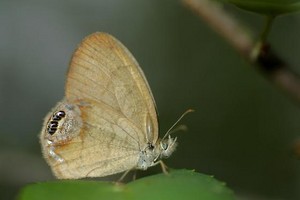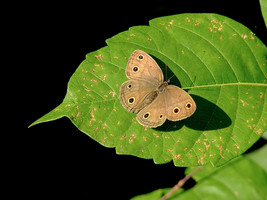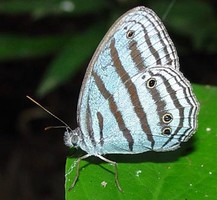Euptychiina
Andrew V. Z. Brower


This tree diagram shows the relationships between several groups of organisms.
The root of the current tree connects the organisms featured in this tree to their containing group and the rest of the Tree of Life. The basal branching point in the tree represents the ancestor of the other groups in the tree. This ancestor diversified over time into several descendent subgroups, which are represented as internal nodes and terminal taxa to the right.

You can click on the root to travel down the Tree of Life all the way to the root of all Life, and you can click on the names of descendent subgroups to travel up the Tree of Life all the way to individual species.
For more information on ToL tree formatting, please see Interpreting the Tree or Classification. To learn more about phylogenetic trees, please visit our Phylogenetic Biology pages.
close boxIntroduction
With the exception of the Taiwanese Palaeonympha, Euptychiina are an exclusively New World, mainly neotropical satyrine clade. A few species and genera extend into the U. S., including Megisto, Hermeuptychia and Cyllopsis, but the vast preponderance of species occur in tropical Central and South America. Most species are monocot feeders, but a few, such as members of Euptychia, feed on unusual hosts such as the spikemoss Selaginella.
Discussion of Phylogenetic Relationships
It is becoming increasingly apparent (e. g., Murray and Prowell 2005; Peña et al. 2010) that many euptychiine genera are para- or polyphyletic, and significant effort will need to be invested to sort out relationships among members of this clade. Some putative sister taxa are identified in the above tree based mainly on Peña et al. (2006, 2010), but even these hypotheses are in need of corroboration.References
Forster W. 1964. Beiträge zur Kenntnis der Insektenfauna Boliviens. XIX. Einleitung Lepidoptera III. Satyridae. Veröffentlichungen der zoologischen Staatsammlung München 3: 81-160, plates 25-33.
Lamas G ed. 2004. Atlas of Neotropical Lepidoptera. Checklist: Part 4A Hesperioidea - Papiionoidea. Gainesville: Scientific Publishers/Association of Tropical Lepidoptera.
Miller LD. 1968. The higher classification, phylogeny and zoogeography of the Satyridae (Lepidoptera). Mem. Amer. Entomol. Soc. 24: 1-174.
Murray D, and Prowell DP. 2005. Molecular phylogenetics and evolutionary history of the neotropical satyrine subtribe Euptychiina (Nymphalidae: Satyrinae). Mol. Phylogenet. Evol. 34: 67-80.
Peña C, Nylin S, Freitas AVL and Wahlberg N. 2010. Biogeographical history of the butterfly subtribe Euptychiina (Lepidoptera, Nymphalidae, Satyrinae). Zoologica Scripta 39: 243-258.
Peña C, Wahlberg N, Weingartner E, Kodandaramaiah U, Nylin S, Freitas AVL, and Brower AVZ. 2006. Higher level phylogeny of Satyrinae butterflies (Lepidoptera: Nymphalidae) based on DNA sequence data. Mol. Phylogenet. Evol. 40: 29-49.
Title Illustrations

| Scientific Name | Cyllopsis gemma |
|---|---|
| Location | Chattahoochee Nat'l Rec Area, Medlock Bridge, Georgia, USA |
| Specimen Condition | Live Specimen |
| Source | Gemmed Satyr - Cyllopsis gemma |
| Source Collection | BugGuide.Net |
| Image Use |
 This media file is licensed under the Creative Commons Attribution-NonCommercial-NoDerivs License - Version 2.0. This media file is licensed under the Creative Commons Attribution-NonCommercial-NoDerivs License - Version 2.0.
|
| Copyright | © 2002 Troy Bartlett |
| Scientific Name | Megisto cymela |
|---|---|
| Location | Arlington, Texas, USA |
| Specimen Condition | Live Specimen |
| Source | Butterfly away? |
| Source Collection | Flickr |
| Image Use |
 This media file is licensed under the Creative Commons Attribution-NonCommercial-NoDerivs License - Version 2.0. This media file is licensed under the Creative Commons Attribution-NonCommercial-NoDerivs License - Version 2.0.
|
| Copyright | © 2006 DeWaun Simmons |
| Scientific Name | Cepheuptychia cephus |
|---|---|
| Location | Manu, Peru |
| Specimen Condition | Live Specimen |
| Identified By | Kim Garwood |
| Sex | Female |
| Life Cycle Stage | adult |
| View | ventral |
| Source | Cephus Satyr |
| Source Collection | Neotropical Butterflies |
| Copyright | © 2004 Kim Garwood |
About This Page

Middle Tennessee State University, Murfreesboro, Tennessee, USA
Correspondence regarding this page should be directed to Andrew V. Z. Brower at
Page copyright © 2011
 Page: Tree of Life
Euptychiina .
Authored by
Andrew V. Z. Brower.
The TEXT of this page is licensed under the
Creative Commons Attribution License - Version 3.0. Note that images and other media
featured on this page are each governed by their own license, and they may or may not be available
for reuse. Click on an image or a media link to access the media data window, which provides the
relevant licensing information. For the general terms and conditions of ToL material reuse and
redistribution, please see the Tree of Life Copyright
Policies.
Page: Tree of Life
Euptychiina .
Authored by
Andrew V. Z. Brower.
The TEXT of this page is licensed under the
Creative Commons Attribution License - Version 3.0. Note that images and other media
featured on this page are each governed by their own license, and they may or may not be available
for reuse. Click on an image or a media link to access the media data window, which provides the
relevant licensing information. For the general terms and conditions of ToL material reuse and
redistribution, please see the Tree of Life Copyright
Policies.
- First online 01 November 2006
- Content changed 16 May 2011
Citing this page:
Brower, Andrew V. Z. 2011. Euptychiina . Version 16 May 2011 (under construction). http://tolweb.org/Euptychiina/70791/2011.05.16 in The Tree of Life Web Project, http://tolweb.org/











 Go to quick links
Go to quick search
Go to navigation for this section of the ToL site
Go to detailed links for the ToL site
Go to quick links
Go to quick search
Go to navigation for this section of the ToL site
Go to detailed links for the ToL site